A new study from researchers at New York University looking at how the shape of the human lumbar spine has evolved over time, has suggested that modern day humans spines are more similar to Neanderthal spines than previously thought.
The side on view of the human spine is not straight, it has four natural curves: in the neck (cervical spine), midback (thoracic spine), low back (lumbar spine) and tail bone (sacrum). These curves have evolved to allow humans to stand up straight and walk on two legs.
The lumbar spine curve is essential for balance and for the correct position of the head and body above the hips, knees and ankle joints for most efficient muscle use during (bipedal) walking and maintaining and upright posture. The curves in the spine are created not only by the shape of the spinal bones (vertebrae) but also the discs between the bones and the supporting muscles.
Previous studies have compared the shape of the Neanderthal spine with modern, post-industrial revolution humans spines. They concluded that Neanderthal spines were straighter than modern humans because they had not yet evolved enough. However the latest study, which examined over 1660 spines, comparing Neanderthal spines to pre-industrial modern humans and post-industrial modern humans and found that Neanderthal and pre-industrial human spines were more similar in shape compared to post-industrial human spines.

“Past research has shown that higher rates of low back pain are associated with urban areas and especially in ‘enclosed workshop’ settings where employees maintain tedious and painful work postures, such as constantly sitting on stools in a forward-leaning position,” study co-author Scott Williams from New York University said in a statement.
Hence a change of lifestyle from hunter-gatherer to sitting in chairs and working in factories has changed the shape of our spines and most probably contributing to the global problem of back pain.


